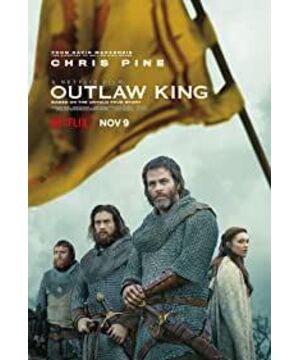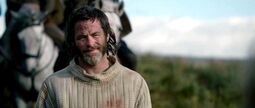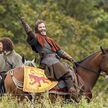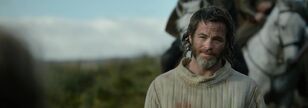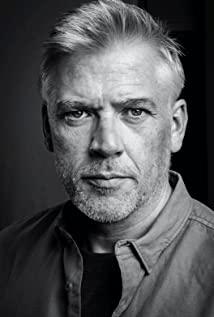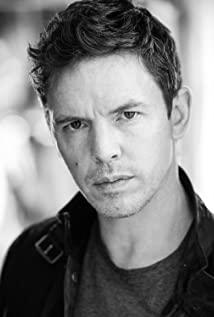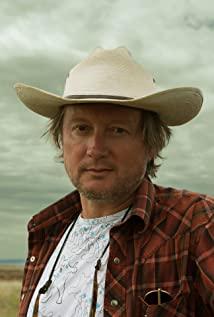The content of this article is collected from the English version of Wikipedia (because the content of the Chinese version is too small, if there are translation deviations, we will not be responsible. If there are supplements and corrections, please leave a message. Anyway, I am lazy, so I am too lazy to change the wrong place as always)
Before introducing the movie, first introduce the background knowledge.
The plot in the film mainly took place during the First Scottish War of Independence, and the specific time took place between 1296 and 1328 AD. In 1286, due to the death of King Alexander III (King Alexander III) who ruled Scotland at the time, the question of heirs arose. The first heir at that time was the granddaughter of Alexander III, Margaret (Margaret, Maid of Norway), but this heir had lived in Norway since birth and was only a child (the family was still a baby), so Scottish The lord established a governmental guardian system, so that when Queen Margaret grows up, she can take charge of the government. But it is a pity that the "queen" of Scotland who had never met before fell ill and died on the way to Scotland, on September 26, 1290. After the death of this heir, Scotland has been in a crisis of civil war for the throne of Scotland, because a group, a group, and a group of Scottish lords are eligible to obtain the throne of the Scottish king. Especially the granddaughter of Alexander III, the first heir, and the state of being far away in Norway, these other qualified lords are basically the various distant relatives of Alexander III).
(A similar historical plot also appeared in another movie "Mary Queen of Scots" released in 2018. That is, Queen Mary of Scots also remotely controlled Scotland in France before, when her husband, then King Francis II of France, died. , She returned to Scotland to govern. The historical time in the film is roughly between 8 December 1542-8 February 1587.)
When Scotland is about to fall into the crisis of civil war, one of the supporting characters in the film makes a debut (unfortunately only a supporting role)-King Edward I of England. In fact, Edward I was invited by the aristocracy of Scotland to enter Scotland and act as the adjudicator against the King of Scotland. The election of "Yuan Shao" can basically be understood as the introduction of wolves into the house. Unfortunately, Wikipedia does not specify which group of "Yuan Shao reincarnated" Scottish nobles invited Edward I. The grievances between Scotland and England are not listed one by one. The most famous is probably the movie "Brave Heart". In fact, the historical background described in "Brave Heart" is the same period as the film. At that time, the Scottish Lords in the movie All kinds of intrigue, what kind of infighting must first be settled outside the capsule, is vividly visible. Therefore, according to the enthusiasm of these Scottish lords to fight for the throne, I am afraid that even if the "Queen" of Marquette does not die on the way to Scotland, there will be a small accident in the future growth process. (Digression: The hero in "Brave Heart" actually helped the more useless king in this film. Bruce is called the Bruce I after becoming the king of Scotland. The name is also named from Robert Bruce becomes Robert the Bruce, this person feels like a "zi", such as Confucius and Mencius, similar to a respectable name)
Just before King Edward I of England arrived in Scotland, and before the ceremony of electing the king of Scotland began, the hungry wolf of Edward I directly showed his ambitious side of Scotland. He demanded that all Scottish lords respectfully call him "Scottish supremacy." "Lord Paramount of Scotland" (Lord Paramount of Scotland). Then in the subsequent elections, John Balliol was elected as the new king of Scotland (this king is really a trash, or a weak king for short), because Edward I not only instigated other new Scottish kings against this “trash” He also forced the new king to go to the British court as the plaintiff. As for what he claimed was not known. (On the other hand, in fact, the most favorable contenders running for the throne of the King of Scotland at that time were Bruce, Comyn (detailed below) and John Balliol, but John's blood inheritance is more likely to be in the front.)
In 1296, the new "junk" king of Scotland re-declared his status as king. The main reason for this oath of sovereignty was the war between Britain and France in the same year. The main source of famous figures, such as Joan of Arc, lies in the Duke of Normandy—that is, William the Conqueror sent troops from Normandy to attack the British mainland, and then became the king of England, so that the latter kings always believed that the center of Britain was in the European continent. Normandy, not the British Isles, is committed to participating in the affairs of the European continent. The first thing to bear is the dispute with France. In addition, the nobles of the European continent are relatives, so once the French king passes away, other countries often covet the French king's throne), and The new King of Scotland announced that Scotland refused to help (actually more like funding money and soldiers) in the war between British troops and France. Therefore, in the same year, Edward I led an army to invade Scotland, and later defeated the Scottish army at the Battle of Dunbar. Because of the limited material, the specific casualties on both sides were unknown (not written in the Wiki), but as a result of the war. , King Edward I forced the new King of Scotland, John Balliol, to abdicate (in fact, this waste has always been a king, it is completely puppet characteristics, there is no need to abdicate), and Edward I arrested 1,800 Scottish nobles (some It was captured in the Battle of Dunbar, well, Scotland is not a big place, but there are many nobles), so far, Scotland is ruled in the hands of King Edward I of England.
In the following years, Scotland has been dissatisfied with the rule of England, and there have been uprisings from time to time. The most successful of these was the battle of Stirling Bridge, which successfully drove the English team out of Scotland and commanded the battle. It’s William Wallace. He is a patriot in Scotland. He seems to be a lord, but he is not a lord or nobles, but a landowner, so he feels like a low-status landlord, or Is the patriarch of the tribe (it feels that the movie "Brave Heart" is based on him). After successfully driving off the English invaders, Wallace also planned and commanded a series of campaigns to attack the British mainland, but the good times did not last long, which can be understood as being sold by his teammates. In January 1298, the then King Philip IV of France announced a truce with King Edward I of England. At the same time, the armistice agreement did not include the clause of the armistice between England and Scotland, that is, the King directly sold Scotland to the King of England, and then exchanged it. armistice. There is one more detail here. When Wallace fought against the British army, King Edward I of England was not on the front line. He should be fighting in France, and other British aristocrats did not put Wallace in their eyes, of course. This arrogance comes at a price. After the signing of the Anglo-French armistice agreement, since the two big brothers had a truce, it was time for the big brother to beat up the little brother (Scotland). In July 1298, the British army attacked the Scottish army led by Wallace, because The Scots are outnumbered and are subject to the attack of the British longbowmen (played in Age of Empires 2 should have understood the powerful range of the English longbowmen. In the future Anglo-French Hundred Years War, the French Knights also deeply Having learned the power of the English longbowman-described in Shakespeare's empty crown), the Scottish army led by Wallace should have been wiped out, and Wallace's honor was lost. Objectively speaking, because Wallace had not faced King Edward I of England in the previous battles, it was a lesson for the Scots after this battle. (Of course, there are still some people who do not believe in evil and choose to fight hard against the English army. "The Brave" is the protagonist Bruce in the film)
In 1299, King Edward I of England was under pressure from France and the Pope. Edward I released the captive King of Scotland John Balliol who was forced to abdicate (well, after he was forced to abdicate, he was kept in British custody). At the same time, the Pope asked Edward I to retreat from Scotland and negotiate with Scotland, but the British King Edward I ignored the Pope’s "rude" request. This also shows the waste of the former King of Scotland. He let it go: forgive you for not being able to make much splash, by the way, sell the Pope in Rome. At the same time, Wallace was sent to the European continent to seek help from other countries (mainly France) to counter the United Kingdom. At this time, Scotland established a regency system that could be regarded as a protector of the country, controlled by Bruce and another Scottish lord Comyn. , The main reason is also because Bruce and Comyn are incompatible with each other as to who will be the king of Scotland, and the two sides are considered evenly matched (this is also reflected in the movie).
In March 1300, King Edward I of England summoned knights, lords and armies from all over Britain (except Wales), and then led an army to invade Scotland. During the period, Scotland and the United Kingdom had victories, but the United Kingdom won most. At the same time, in the regency system introduced in the previous paragraph, the members of the regency resigned or were replaced by others. Bruce was also one of the resignations. It lost in command of the war against Britain. The castle of Stirling that was first besieged in the movie has always been the focus of the war, changing hands repeatedly during the period.
Movie time-officially started
In April 1304, King Edward I of England led an army to the Castle of Stirling once again, and carried 17 siege equipment. In the movie, there is a close-up of one of the giant trebuchets (War Wolf?).
Here is a side knowledge. In medieval Europe, generally speaking, the main choice for besieging castles is siege rather than direct siege. On the one hand, the attacker’s losses will be very huge if the attacker is forced to attack the city directly, such as the defender. The location of the medieval castle is very easy to defend and difficult to attack. Throwing an apple at the head of the city can kill people, and the main way to win the attacking party surrounding the castle is actually to encircle the opponent. , Let the defender run out of ammunition and food (mainly food), or negotiate, exchange profit for the defender’s surrender, and then use insidious tricks, such as sending meticulous agents to poison the city, opening the city gate or assassinating it. Defensive generals and other means. Therefore, in the absence of large-scale siege equipment, a general siege is more like a cutscene, and the offensive side really surrounds it-build a wooden wall outside the castle (like a city in a city), and the defense side is pretending to be a posture. Defensively-sing and ridicule the siege party loudly while singing at the top of the city. Together, we will wait for the changes in the right time and place, and wait for a chance to win. Therefore, what I have to focus on is the fall of Constantinople in the future (forget the specific date), because the Ottoman Empire at that time was the first to use artillery during the siege to bombard the walls of the fortified Constantinople, and A huge gap was opened (Assassin’s Creed is described here), so that the Ottoman army successfully captured the capital of the Eastern Roman Empire. At the same time, it also announced the end of the "Greek Fire"-style Middle Ages and the arrival of the age of firearms. . The use of artillery also announced the decline of the medieval product of the castle (Castle), which is exactly the case. In future European wars, all major battles are basically field battles, and siege wars rarely occur.
At the same time when King Edward I of England besieged the Castle of Stirling in 1304, the nobles of Scotland, except Wallace, all surrendered to Edward I, including Bruce. This scene is reflected in the movie. (There is also a time difference here. Edward I’s siege of Stirling took place in April, because he arrived in April, but the surrender of the Scottish lords took place in February, which shows that I am really aware of the current affairs)
But on June 11, 1304, Bruce and Wallace signed an agreement on friendship and alliance-in fact, it was almost like worshipping a hand, not hurting each other's feelings. Later in the same year, because the Scottish lords had already surrendered to the British king, the British Parliament sent the nephew of Edward I (Earl of Richmond) as the controller of Scotland. At the same time, Wallace was unfortunately captured by the British. , And was hanged in London on August 23 of the following year (estimated to be the Tower of London). There are great exaggerations and descriptions of this article in the movie, but from my personal opinion, objectively speaking, based on the situation of internal friction in Scotland at that time, there will be some Scottish lords who do not like Wallace because of his Rebellion against Britain will only exacerbate the danger of Scottish civil war.
In September 1305, because King Edward I trusted Bruce so much, he awarded him a castle (Castle at Kildrummy). But in October of the same year, Robbit Bruce, as the nobleman of Scotland, declared that he had the right to the throne of Scotland. (It can also be understood here why King Edward I was angry. It was almost the same as eating a fly. As soon as the front foot was commended, the back foot was slapped in the face by the opponent's "rebellion")
Although Bruce claims that he has the qualifications of the King of Scotland, but in the background above, there may be a bunch of Scottish nobles who are qualified like Bruce. Anyway, everyone is a distant relative of Alexander III, who is afraid of whom. And because Bruce often wandered in support of Britain and Scotland (a bit on the fence), his relationship with other Scottish lords became very stiff. (I guess everyone thinks too, who knows whether he supports independence this time is true or is acting) The most famous representative is the other lord of the regency system introduced above, Comyn, besides Bruce (can be co-regent with Bruce at the same time) , It can be seen that the status is high).
In the summer of 1305, Comyn and Bruce reached a secret agreement. Comyn gave up his claim to compete for the throne of the King of Scotland. History does not record whether Comyn agreed to this agreement, but Comyn turned around and leaked the agreement to King Edward I. It was true. of. Then in February of 1306, Bruce decided to eliminate the roots and take the lead in solving the "traitor" Comyn. At the same time, there is another completely different record: Comyn's killing was only Bruce's method of excluding dissidents in order to fight for the throne, and that secret agreement did not exist at all. (If there is a secret agreement, it is estimated that those who know it should reflect on why they know the secret). In the movie, a more compromised plan was adopted—that is, with this secret agreement, Comyn had not revealed the secret to King Edward I. Then Bruce directly solved Comyn's ruthlessly. Of course, the cost of this behavior, Although Bruce did not get retribution in the future, his son had to pay the price of this reckless behavior throughout his life.
In just six weeks after eradicating the most dangerous competitor Comyn, Bruce finally ascended to the throne of the king of Scotland-known as Bruce I in history.
In June 1306, the battle where Bruce was defeated for the first time in the movie (Battle of Methven), the movie depicts Bruce and the commander of the British army (de Valence) agreed to a one-on-one duel, the British army The commander pretended to agree and insisted that it should be the next day because it was Sunday. Then when the black wind was high that night, the British broke their promises and attacked the unsuspecting Scottish army, and finally wiped out most of the Scots. Only Bruce and a small number of his men escaped. This is regarded as one of the most outrageous parts of the real history, and it is also one of the reasons for the very low scores of the film. There is no need to write the British so mean. The real situation is that Bruce and Valence are fighting in a certain place (not one-on-one). Valence chooses to refuse. Bruce thinks that Valence's refusal is a sign of weakness, so Bruce was not around the camp when he set up a camp later. A scout post was placed, and Valence wisely chose the night attack as described in the movie. As a result, the Scottish army led by Bruce was defeated. (In the Rotten Tomatoes rating, the film only received 63% praise, with an average score of only 6.2/10; in the Metacritic rating, it only got a 60/100 rating)
In real history, Bruce's failure was entirely due to improper personal command. He only fled the war with a few of the most loyal to him. What's better than Uncle Liu is that he ran with his wife and children. Unfortunately, his wife and children were later captured by the British army and detained for four years. At the same time, his brother was also captured and executed (being hanged, drawn, and quartered). But luck always falls from the sky. In July of the same year, a generation of heroes, Edward I, passed away, and it was Edward II, the arrogant maniac in the movie, who took over the throne. (This is also inconsistent with the movie. In the movie, Bruce led the army, and then Edward I led the army to conquer, and died on the road. Edward II madly drove the ducks to the shelves, and Edward II was not so arrogant, so please Face your opponent)
Between 1306 and 1307, Bruce did not show up, he has been hiding in secret locations (the exact location is unknown). He didn't show up until 1310. There is evidence that he didn't do nothing all the time. In 1309 he was supported by the lord of northern Scotland. After gaining favorable support, in 1310, Bruce sent a letter to Edward II seeking a truce and peace between England and Scotland. Obviously, Edward II did not accept it, and then in the following three years, Bruce successfully occupied three castles and ports controlled by the British army. Moreover, Bruce kept harassing the British army, but he never fought head-on with the British army (he finally learned his lesson. Another explanation is that the army is not strong enough to contend with the British army head-on. This was also when Yuan Shao was about to attack Cao Cao. , His counselor first suggested to Yuan Shao not to concentrate on attacking with all his strength. The harassment alone can make Cao Cao exhausted to cope with it and eventually lead to failure). It wasn't until the Bannockburn battlefield in 1314 that Bruce finally fought the British army head-on. Of course, the cause of the battle was the siege of the castle Stirling by the Scottish army (why is this castle again!).
(Thank you for the correction in the comment below) The last scene in the movie is the Battle of Loudoun Hill ---- took place in May 1307. The two sides of the battle were the Scottish army led by Bruce and the British led by the British general Aymer de Valence. The number of soldiers in Scotland is 600, and the number of British troops is about 3,000. Bruce used spearmen to hit the unorganized British knights on the downhill (terrain). Here you can also see the degree of British contempt for Scotland (no organized attack at all). In the end, the British army paid more than one hundred or hundreds of casualties. In addition, the one thing I suspect in the film review is that Bruce let Edward II go. Regarding this point, it should be false. The reason is that King Edward II did not participate in this battle. So the last scene of the film involves everything. To Edward II, it is basically a deduction to add a large amount of the effect of Bruce's adults, and Edward II's "dog eating shit" and "barking" behaviors at least did not appear in this battle.
———————————————————————————————————————————
Add some other knowledge below
In the first Scottish War of Independence, the most critical battle was the Battle of Bannockburn
Battle of Bannockburn. The incident took place on June 23 and 24, 1314. The British army was led by Edward II and the number was between 15,000 and 20,000, while the Scottish army led by Bruce was about 5,500 to 6,500. , Dominated by spearmen. As for the specific plot, you can read the entry in the Wikipedia below, (because there are more tactical terms, the specific process of the battle is not detailed) (PS can see that the Castle of Stirling has appeared again by looking at the map below. This castle is simply the epitome of Scotland’s First War of Independence)
Battle of Bannockburn
If you can’t open the link or are too lazy to read, you can see the two pictures below (the top is the first day, the bottom is the second day), the red one is the British army led by Edward II, and the blue one is the Scottish army led by Bruce . In the first scene of the movie, there is a certain expression of the dangerous geographical position of the castle. It can be seen from the height that if the Scottish army successfully captures the castle, it will be for the British on the road to invade Scotland in the future. A huge obstacle will be added. The laborious process of the late King Edward I's use of 17 huge siege equipment to capture the castle is still vivid.
The result of this battle was that Edward II was dragged away by his escorts (maybe he fled on his own initiative, but he fleeed anyway), and this escape led to the spread of panic in the army, which eventually led to being defeated and turned into a rout (of course this This escape was after the defeat on the battlefield the next day). (From the above two pictures, there will be a question, why the British army would foolishly attack the Scottish army from that narrow area, because there are two bridges for the British army to cross the river, and the river beach in the northeast of the map is a swamp area. Conducive to fighting across the river.)
Edward II finally died in the murder of his courtiers. On the one hand, it was due to the defeat of the war with Scotland. On the other hand, it was due to the vengeance battle between Edward II and a very high-ranking lord in the United Kingdom, and also The influence of the Anglo-French War and the final superposition of various factors led to the gradual loss of Edward II's rights, and was finally forced to abdicate, followed by imprisonment and death.
Finally, on the value of this film, I personally think that it is at best to make people interested in re-understanding the Scots' War of Independence against British rule, but this film can be regarded as a commercial film at most. Demonizing Britain, while writing himself tall, Bruce is the independent hero of Scotland on the road to the King of Scotland, but his behavior cannot be said to be so glorious. At the same time, there is not much description of the hidden dangers of Scotland after its first independence. So it is neither a historical film nor a documentary, but a commercial film. It is precisely because of this that it embodies the respectability of the movie "Brave Heart". Although it is full of personal heroism, it depicts the infighting and the intrigue between the Scottish aristocrats and the intrigue.
Let me add one more thing. After Bruce defeated King Edward II at the Battle of Bannockburn, he won a series of battles and finally achieved the re-independence of Scotland. However, the ending has already been revealed at the beginning, that the Comyn killed by Bruce actually represents another faction in Scotland, and this faction does not agree with Bruce's qualification to inherit the throne of the King of Scotland, and also hates Bruce for killing Comyn ( It is estimated that he hates the methods he uses, rather than defeating Comyn on the battlefield). Therefore, after the death of Bruce I in 1329, the crisis of the Scottish civil war was once again revealed, and this time the fate of Scotland is not as lucky as it was when Bruce was alive. The son of Bruce I, the new King of Scotland, King David II, was a child (well, another child) when he took the throne. He was only five years old at the time, so the opposition within Scotland united with the King David II at the time. Edward III re-launched his invasion of Scotland (it was actually a Scottish Civil War, and the opposition united with King Edward III of England). After that, the Second War of Independence in Scotland began, and this time the end of the War of Independence was the King of Scotland King Victoria II compensated the United Kingdom for a ransom of 100,000merks, and Scotland should be considered a subsidiary of the United Kingdom. In fact, King David II was considered a puppet of the United Kingdom. As for the specific amount of 100,000 merks, a data can be used as a reference. When Edward III died in 1377, the ransom was still 24,000 merks not paid in full, and David II died in 1371 (that is, Said that even if David II died, Scotland still needs to continue to pay the ransom to the United Kingdom, and this is because of David II's "stealth", which made him lose popular support in Scotland). Scotland remained independent until 1707, when England and the Kingdom of Scotland signed an agreement to establish the Kingdom of Great Britain.
PS checked merks value, merk is silver Scotland, has been used until the 17th century, roughly equal to the value of 1 British shilling coin in 1merk Scotland, converted in accordance with the prevailing price should be equal to today's 3.55 pounds, it's still 100,000merks The compensation is equal to 350,000 pounds today. But another data can be used as a reference, that is, in the United Kingdom in 1800, a worker worked six days a week in a textile factory to get 15 shillings. In short, in the 14th century in Scotland and the United Kingdom, in regions with underdeveloped economies, this was a huge sum of money than indemnities. (If you are interested, you can check the cost of the British in the Anglo-French War at that time. The more detailed the better, it can be used as a reference for better data, and I will add it later when I have time)
Finally, let me talk about Elizabeth de Burgh, the queen of Bruce I. Bruce has two wives in total, but in the movie that is Bruce's only queen when he becomes the king of Scotland. In fact, the background of this queen is not simple. She is the daughter of an Irish nobleman, and this nobleman is a close friend and ally of King Edward I of England. This is exactly why Edward II forced her to take her captive in the movie. The reason for remarrying and choosing to imprison her after being rejected——According to Journey to the West, this Elizabeth is a person with background. Finally, the queen died in July 1326, and then Bruce I followed her 18 months later. (And after Elizabeth was defeated at the beginning of Bruce, she and Bruce's daughter were captured by Comyn's supporters, and then handed over to the King of England, which shows how serious Bruce's subsequent impact after killing Comyn is. )
There are frights and frights below.
The reference link is as follows
First War of Scottish Independence
Battle of Loudoun Hill
Battle of Dunbar (1296)
Battle of Methven
Alexander III of Scotland
Stirling Castle
Robert the Bruce
Battle of Bannockburn
Outlaw King
Edward II of England
Wars of Scottish Independence
This skeleton is a plaster model of the skull of Bruce I. I have never understood how Westerners perceive the positioning and significance of the exhibition of this type of skull model. When traveling in the UK, I have also seen some famous British models in museums. An exhibition of skull models of people (mainly kings, lords, and famous knights).
Tell you don't look at you, don't blame me if you are scared, look at the empty eyes, do you feel that you will fall into another space.
View more about Outlaw King reviews


